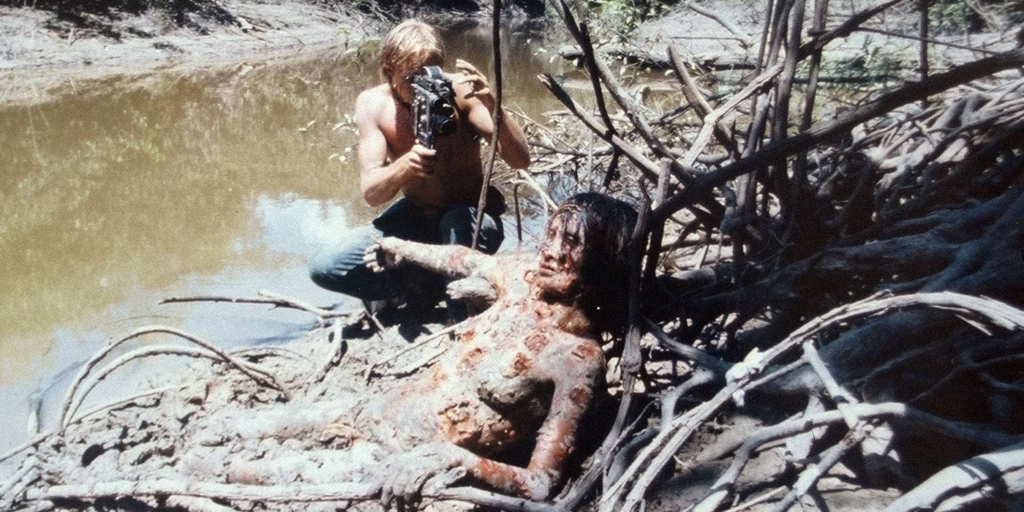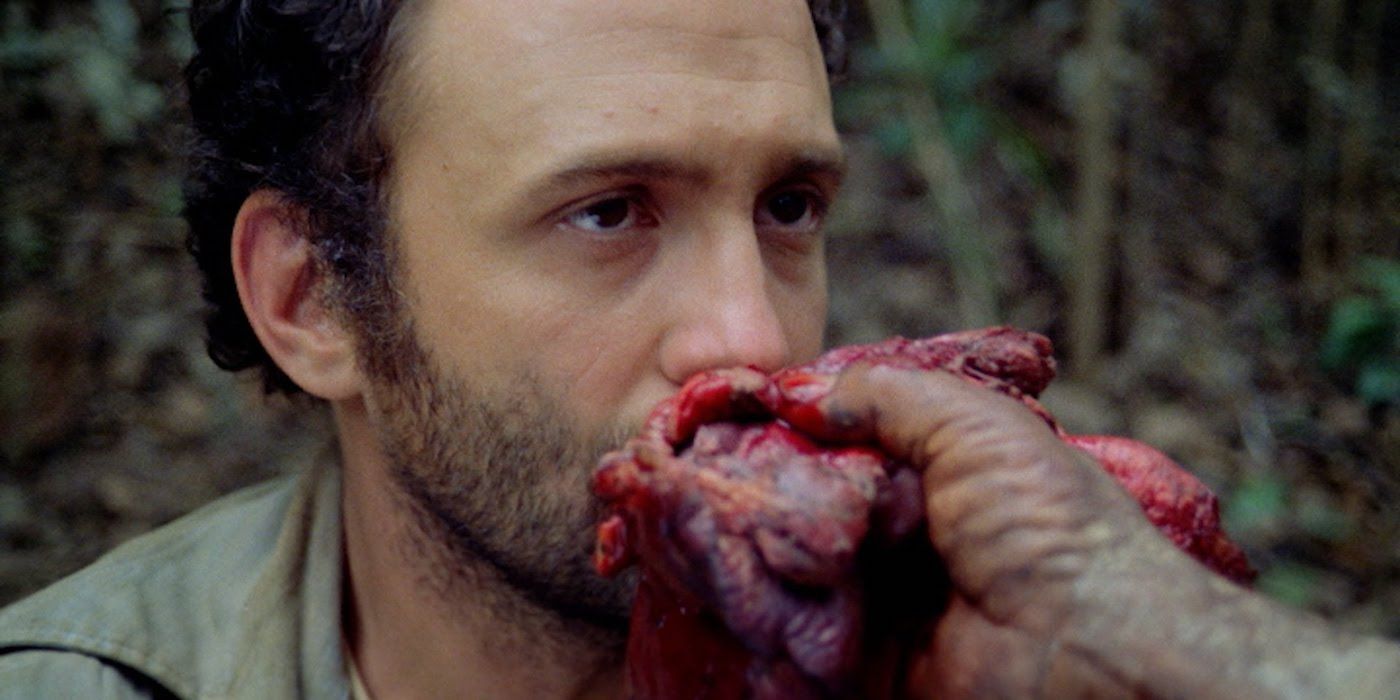- Ruggero Deodato had already made a cannibal film before Cannibal Holocaust, proving himself as a competent director with depth and ideas.
- Cannibal Holocaust is one of the first found-footage films, innovating a new form of visual narrative that blurs the lines between fiction and reality.
- The film crew faced a gruesome shooting process in the Colombian rainforest, and the film itself was embroiled in controversy and accusations of being a snuff film.
When Ruggero Deodato decided to become a filmmaker, the last thing he would have expected was to be charged with murder. Similarly, the last thing the film industry expected was Cannibal Holocaust. At first, just one of many Italian exploitation movies that were cheap, violent, and sexual, the movie very quickly drew attention in the vein of Andy Warhol: don’t worry about what they print, just measure it in inches. Unfortunately for him, however, Deodato shortly found himself hauled up in front of an Italian court, accompanied by the actors he was accused of murdering in his film. But, in the way only the underground horror scene can, these same controversies would propel him to cult infamy and attract the kind of serious attention that Deodato was seeking all along. Following the director’s death in December 2022, his films continue to find new audiences and remain pillars of the found-footage and horror genres.
‘Cannibal Holocaust’ Was Not Ruggero Deodato’s First Cannibal Film
Deodato had been making films since the 1960s, and he always had a trademark style: flashy, grimy pictures with a hardened edge and plenty of sex and violence. He was one of many Italian directors who facilitated the cannibal boom of the late ‘70s and had already made one such film, The Last Cannibal World, before he got around to Cannibal Holocaust. Although released afterward, his other cult classic, House On The Edge of the Park, was made before Cannibal Holocaust and this movie too explored social complexities, supplemented with lots of gore and nudity. Despite his sensationalist style, he had already proven himself not only a very competent director, but one with depth and ideas worthy of cinematic examination. In the making-of documentary, In The Jungle: The Making of Cannibal Holocaust, Deodato says the idea for the film came about during a discussion with his son, about how the media depicted the terrorist acts of The Red Brigades. When distributors asked for another “cannibals in the Rainforest” movie, he had a clear direction in mind: he was going to challenge the way people’s views of the world around them are shaped, or even distorted, by the media.
What Is ‘Cannibal Holocaust’ About?

Cannibal Holocaust is the story of a professor journeying to the Amazon to discover what happened to a film crew of missing “brave young Americans,” only to realize that this characterization couldn’t have been further from the truth. From the offset, the movie looks at how the mass media portrays its fellow Americans, the marginalization of those outside the land of the free, and what it means to be civilized. The young filmmakers are immediately positioned by the media as victims of native savagery, and when anthropologist Dr. Monroe is sent to find them, it is only through his embracing of the tribespeople that he comes across the lost film reels that will piece the puzzle together.
Broadcasting executives back in New York are foaming at the mouth at the prospect of a new documentary even more sensational than the crew’s previous works. They know the crew and give a basic introduction: team leader Alan (Gabriel Yorke) is a provocateur with a reputation for misrepresenting and manipulating situations for the sake of a good watch, his girlfriend Faye (Francesca Ciardi) can somehow bear his presence, and his two associates Jack (Perry Pirkanen) and Mark (Luca Giorgio Barbareschi) equal him, in that they are all raging assholes. The filmmakers are so focused on sensation and viewing figures, that the sizzle reel they show Monroe includes such antics as the gang forcibly amputating the leg of their guide literal seconds after he suffers a snake bite —they don’t even think twice before dismembering a fellow human. This move sets the tone for what turns out to be the truth about these “brave young Americans.”
‘Cannibal Holocaust’ Is One of the First Found-Footage Films
.jpg)
The second half of the movie focuses on the recovered film, and in doing so, innovates a new form of visual narrative that would go on to become a staple of the horror genre: found-footage. The mysterious footage is shown from the perspective of the execs watching it in a screening room, with sporadic narration from Dr. Monroe as if he is presenting it directly to the audience. This is one among many intricacies that help to blur the lines between fiction and reality that had rarely been explored on film before. The controversial real animal deaths push the viewer into an odd gray area of suspended disbelief, heightened by some truly impressive gore effects. According to In The Jungle, there was a clever idea to prevent the actors from working for a year following the movie’s release, to encourage the idea that the events of the film were real, and they met some terrible fate.
As a lot of lesser found-footage flicks prove, simply shooting a movie from a first-person perspective does not inherently make for an engrossing or believable watch. Without carefully considered direction, it can turn into a blurry mess that is literally sickening to viewers. This is where the competence of Deodato and cinematographer Sergio D’Offizi comes into play: conventionally-shot scenes are given a subtly voyeuristic look, while the found-footage portion is handled with enough control to maintain clarity and narrative structure, yet still read as spontaneous action. For all the trouble found-footage gets for being a lazy form of filmmaking, in its truest form, it is the cinematic equivalent of that wonderful Dolly Parton quote: “It costs a lot of money to look this cheap.” Even when working with a small budget, a lot of thought and craft goes into creating something so casual-looking.
What Happens to the Film Crew in ‘Cannibal Holocaust’?

So, what of the filmmakers’ fate in Cannibal Holocaust? What unspeakable reality is contained in those reels of celluloid? Well, if they came across as unlikeable in their earlier footage, they are soon proven to be truly awful, and perhaps even evil. In keeping with his reputation for fabrication, Alan has a narrative in mind: he will inflict violence upon a village of tribespeople and frame it as an attack by a neighboring tribe. The crew herd the natives into a grass hut and set it ablaze. They rape the women and kill the animals, and Faye’s only objection is that documenting their violence is a waste of precious film. Supposedly capturing most of this for their own satisfaction, all this unedited footage begins to show the extent of the crew’s sadism, which extends way beyond the desire to make big bucks from sensationalist documentaries. Even when the tables turn, and they are on the receiving end of violence, their only concern is getting the shot.
The final sequence of Cannibal Holocaust is wonderfully directed. It’s the only time in the movie that the camera is truly frantic, darting wherever it can to capture the blur of violence in front of it. This frenetic energy is heightened to an almost maddening point by an increasingly loud, shrill shriek that serves as the only musical accompaniment. Intermittent shots of the execs in the viewing room gauge their slowly disintegrating stoicism in the face of an uncomfortable truth, as the crew members are brutally tortured and killed by the tribe in retaliation. Almost to the bitter end, their faces say it all: they will justify this in any way they can because of the dollar signs in their eyes. But by the end of it, even the execs relent and order the footage burned. However, in one last show of corporate cynicism, we find out that the projectionist stole and sold the footage instead. The horror show over, Dr. Monroe steps back out into the concrete jungle of New York, pondering who the real cannibals are.
Source: Collider
